
Monitoring and automation of the mini-shops
Project description
One of our customers, the ‘Sea of Beer’ trade network, turned to us with the task of monitoring the work and automation of its mini-shops. The main motive for implementing such a system for the customer was energy management – and the acquisition of a tool to help develop strategies to reduce the cost of electricity. For example, there is such a thing as the inconsistency of the operation of climatic installations when controlling them manually: the personnel may simply not to switch off the load after a shift, turn the heater on and forget to turn off the air conditioner running for cooling, etc. Thus, automatically maintaining the set temperature, using a schedule to turn off and turn on powerful consumers (chillers, heaters) would already have allowed to partially reduce energy costs.
Obtaining objective data on the consumption profile over time would allow the customer to consider the transition to single- or multi-tariff accounting. Less imortnant, but not least, was the opportunity to receive timely information about violations in the operation of refrigeration equipment (which may affect the quality of the product), as well as the introduction of a ‘single standard’ of temperature for the objects, because now a set level would be maintained automatically.
The stages of this program were:
- Installation of the system on several test objects
- Carrying out of technical audit of work of mini-shops
- Development and implementation of technical and organizational measures to improve the energy efficiency of trade network facilities
- Implementation of the system for whole trade network with simultaneous integration of the monitoring system into the information and analytical system of the enterprise
After getting acquainted with the functionality of our integration controller and conducting a tender for system implementation, the customer decided to do dispatching on WebHMI. The key points for choosing a solution provider were:
- Using an open, ready-made and inexpensive all-in-one platform – one device provides monitoring and remote control via the Internet, SMS and Viber-informing, execution of various scenarios, and process management on a schedule
- Availability of a ready-made dispatch control tool for a large number of WebHMI-based facilities provided by “DDS” LLC – a cloud data processing service Level2
- The presence of an open API and the possibility of close cooperation between developers and specialists of the information and analytical department of the enterprise
Composition of engineering equipment
Lighting:
- Outside ad bar lighting
Ventilation and air conditioning:
- 2 air conditioners (hall and warehouse)
- Exhaust fan
Heating:
- 2 electrical heaters (hall, warehouse)
Electricity supply:
- 1 electric power meter for technical accounting (RS-485, Modbus RTU)
Refrigeration chambers and coolers:
- Cooler
- fish showcase
- several flow coolers
Description of the solution
When implementing the system, we were faced with the fact that the objects are already installed and operated, but the equipment used there is ordinary household appliances (convectors, household air conditioners, etc.) and temperature regulators that do not have the means (input-output channels or interfaces) to integrate them into the automation and monitoring system, the installation had to be made ‘on-the-run’ when the finish was already done, all communications were laid, and right during the store operation, without interfering with the work with customers, whose stores are very popular . This circumstance required finding technical solutions that simplified and speeded up installation work as much as possible and, whenever possible, used wireless solutions: for example, wifi-controlled sockets were used for controlling loads, such as coolers and monitoring of power consumption, for the air-conditioning units – a trained infrared module, and for temperature – inexpensive and easy-to-install 1-Wire sensors.
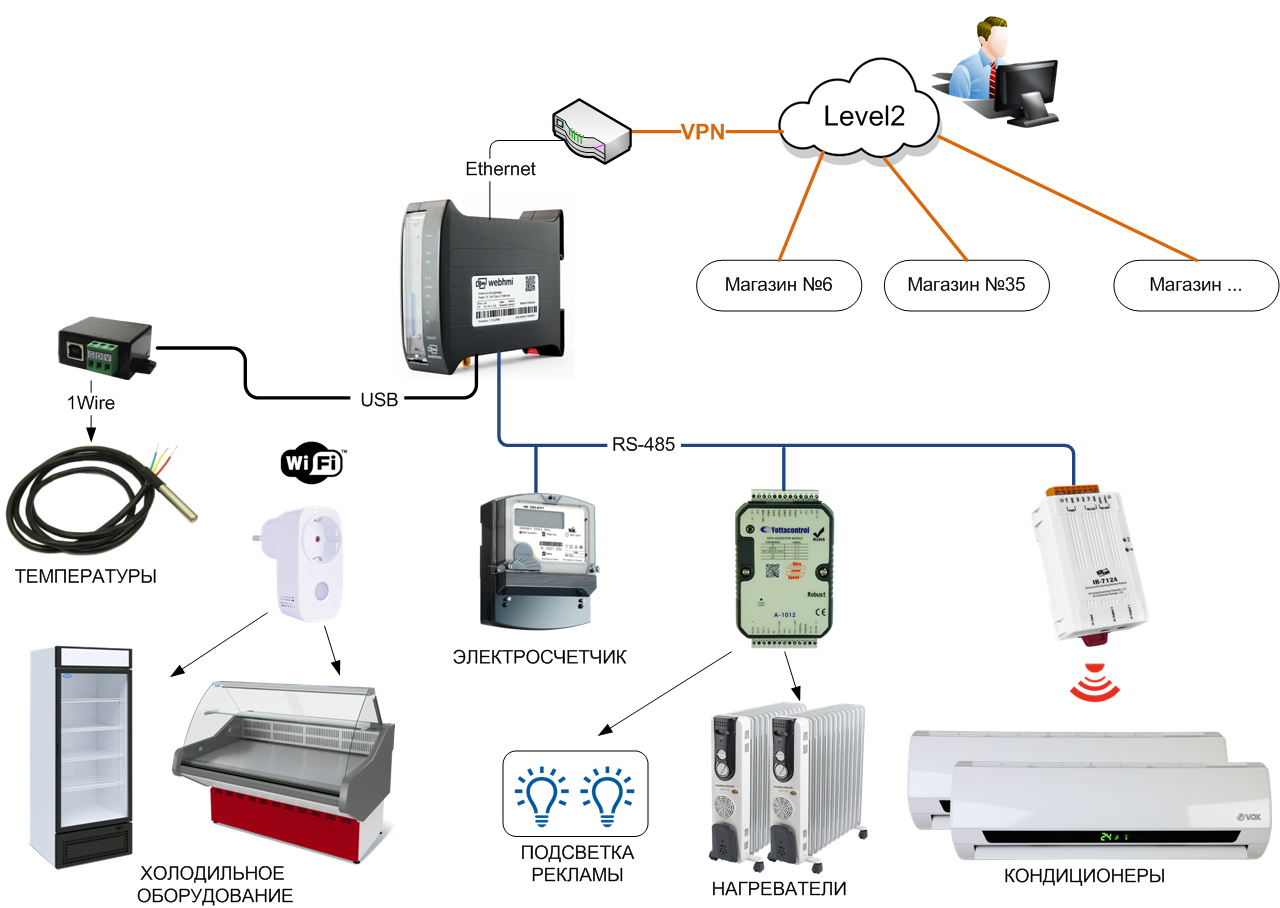
Visualization of the current state
The object management screen consists of 2 screens, on which there are:
- Store plan showing the status of loads, lighting, temperatures
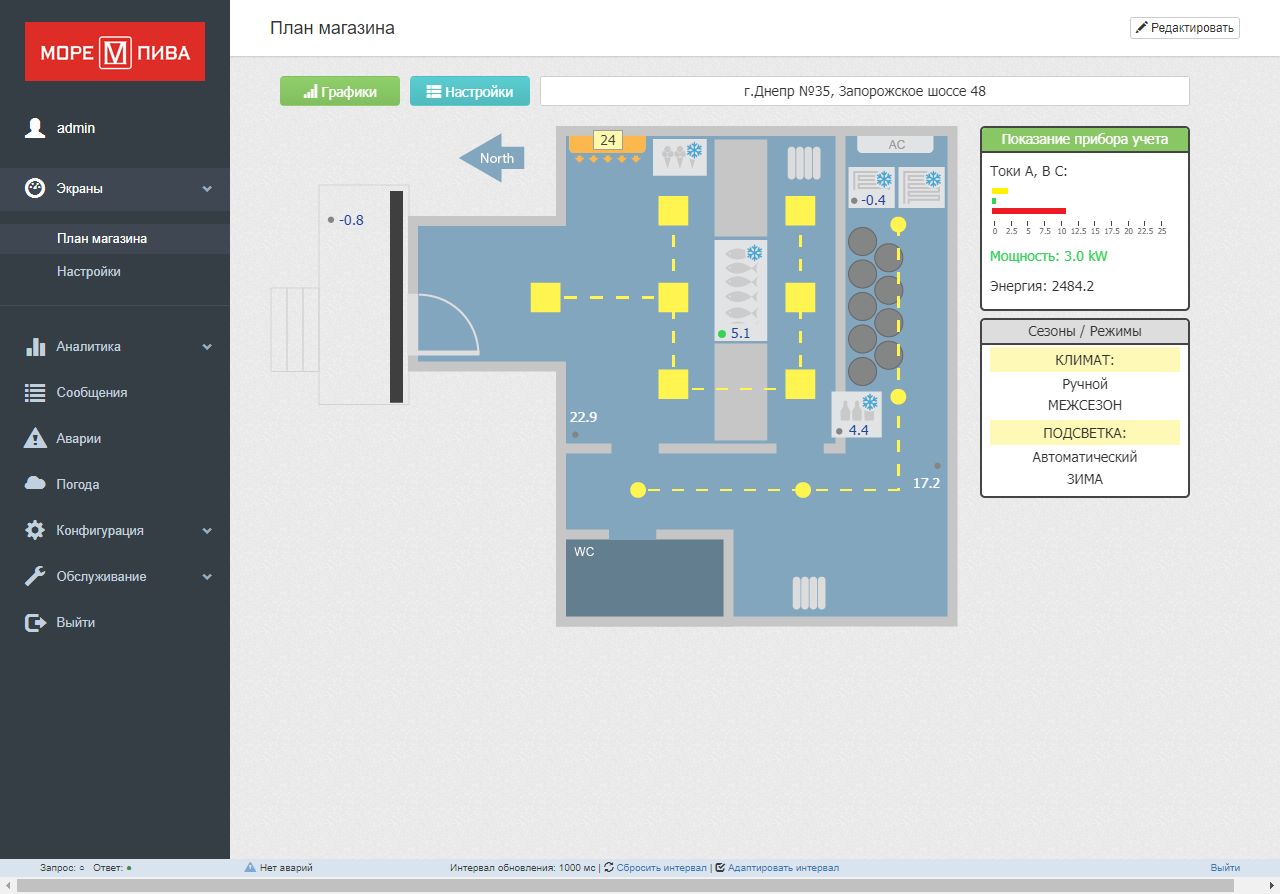
- the settings screen (control pad) on which you can set the modes of operation of the equipment – manual / automatic for climate and lighting separately, temperature settings, the boundary value of the formation of accidents, seasons (winter / summer / off-season), temperature and electrical parameters, system messages
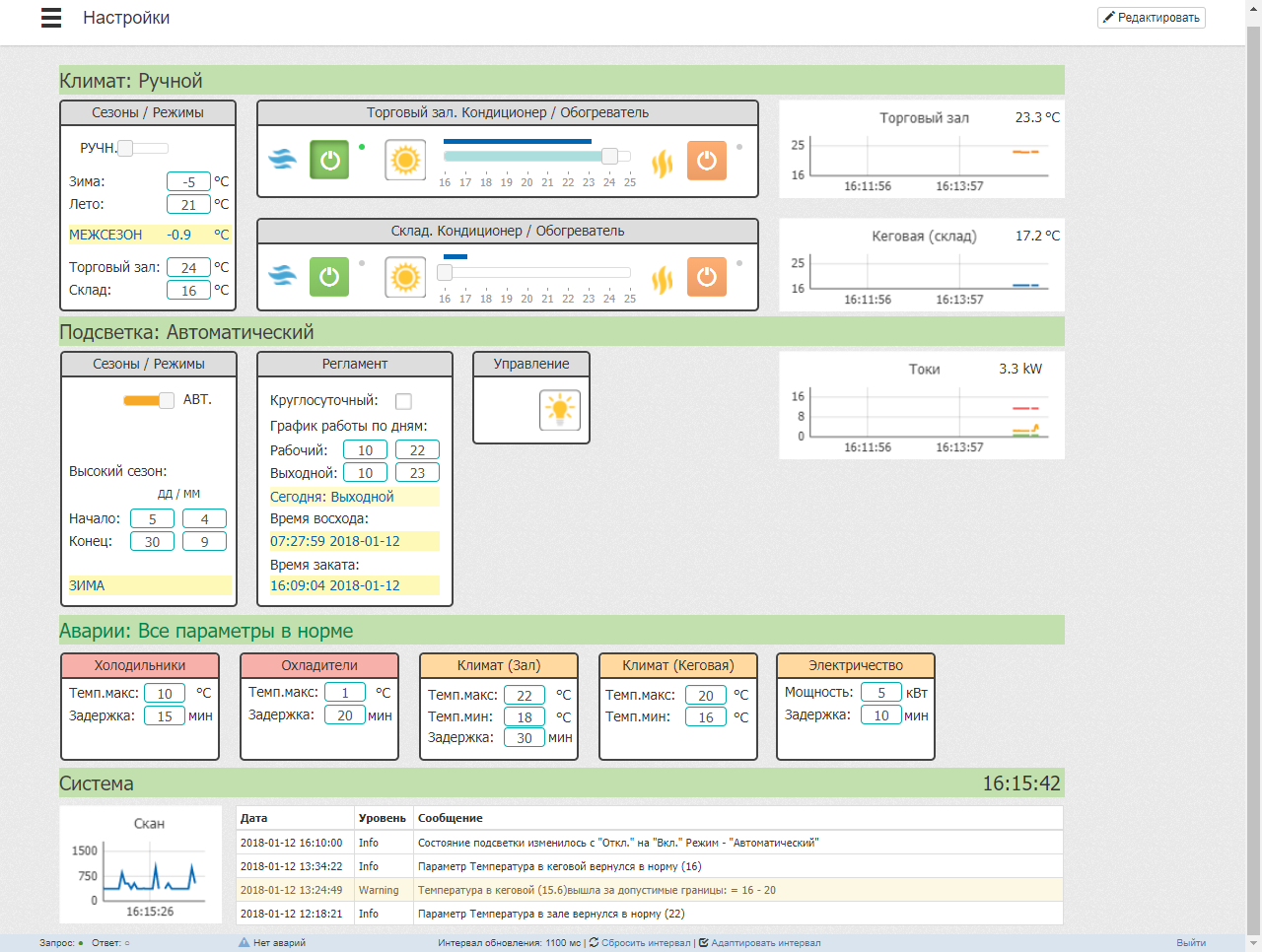
Summary information on network objects is displayed at the top management level Level 2 in the manager in charge virtual office.
Problem objects are highlighted in yellow or red, depending on the level (warning or failure).
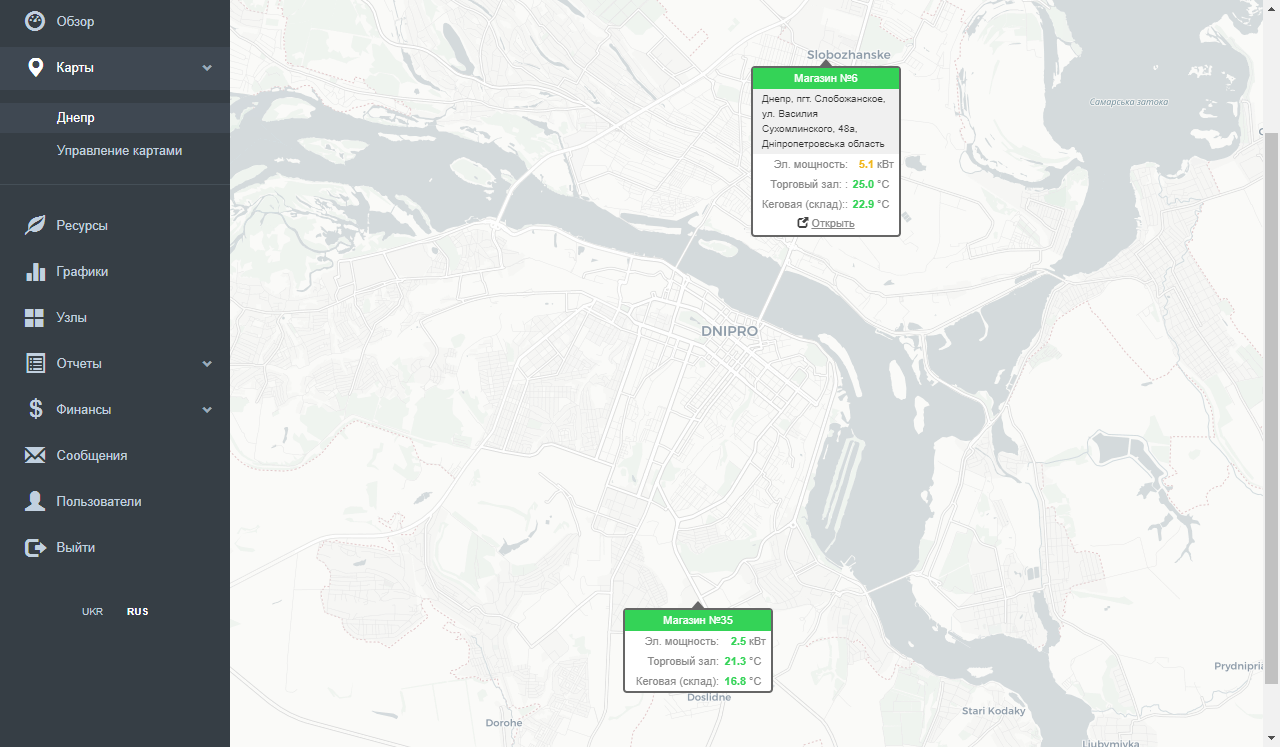
Automatic climate control
In manual mode, the system allows you to set the operating mode (heating / cooling for air conditioners) and manage the loads individually. When automatic mode is selected, the system determines the season by the outdoor temperature sensor and the set limits sor season in such a manner, that: in winter – regulates the temperature of the electric heater. heaters through powerful solid-state relays, and in the summer and in the off-season – air conditioners. Controls algorithms are written in the embedded language of the WebHMI script language lua: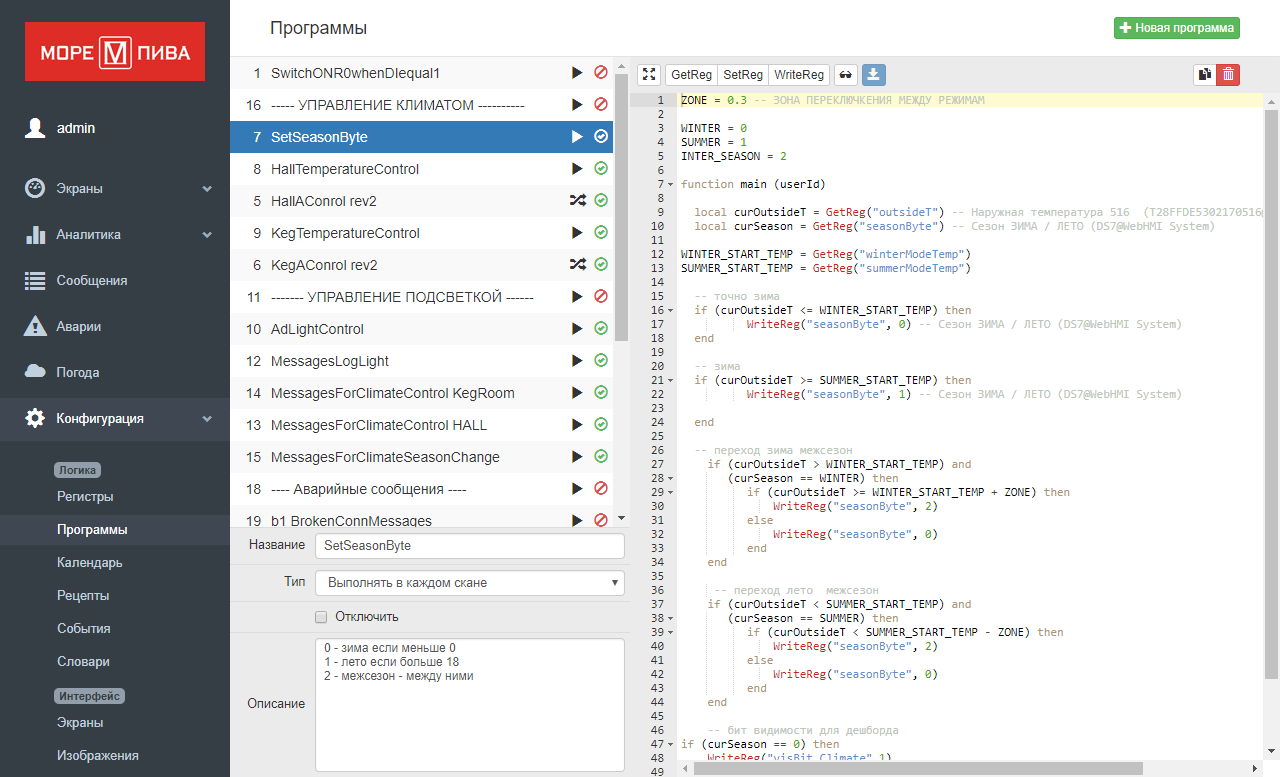
For shops that do not work around the clock, the work of the equipment is blocked at night, and half an hour before the shift starts, the temperature is regulated upon setpoint. The calendar of the store in the manager’s office on Level2 is set for work, weekends and holidays, and on the WebHMI module, the hours of the beginning and the end of the working day.

IR-control of the air conditioners
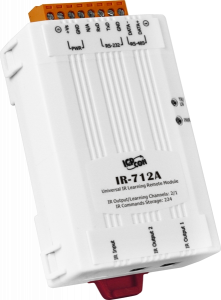
For controlling the air conditioners, a 2-channel IR control module from ICP DAS was used. The module is teached from the a/c remote control and contains a large bank of commands that are activated via the Modbus RTU protocol trough the built-in WebHMI RS-485 port.
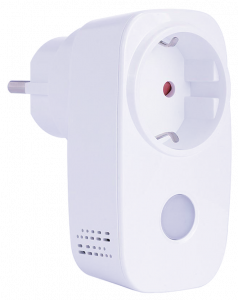 The power consumed by each of the air conditioners is recorded thanks to another interesting solution – a controlled power outlet from Broadlink.
The power consumed by each of the air conditioners is recorded thanks to another interesting solution – a controlled power outlet from Broadlink.This socket, in addition to the wifi load control, also records the power consumption with very high accuracy. The advantage of using such a socket for controlling air conditioners is that some air conditioners do not have the OFF command, but simply change their state to the opposite. Since the IR control has no feedback, there is a possibility of the de-synchronization of the actual status of the air conditioner with its status in the program. With the help of such an socket it is also possible to turn off the air conditioner, then turn it on and set the temperature.
Refrigerating systems and showcases
All the current temperatures and alarm conditions in the cold rooms and showcases are displayed on the main screen and recorded for viewing in the form of graphs.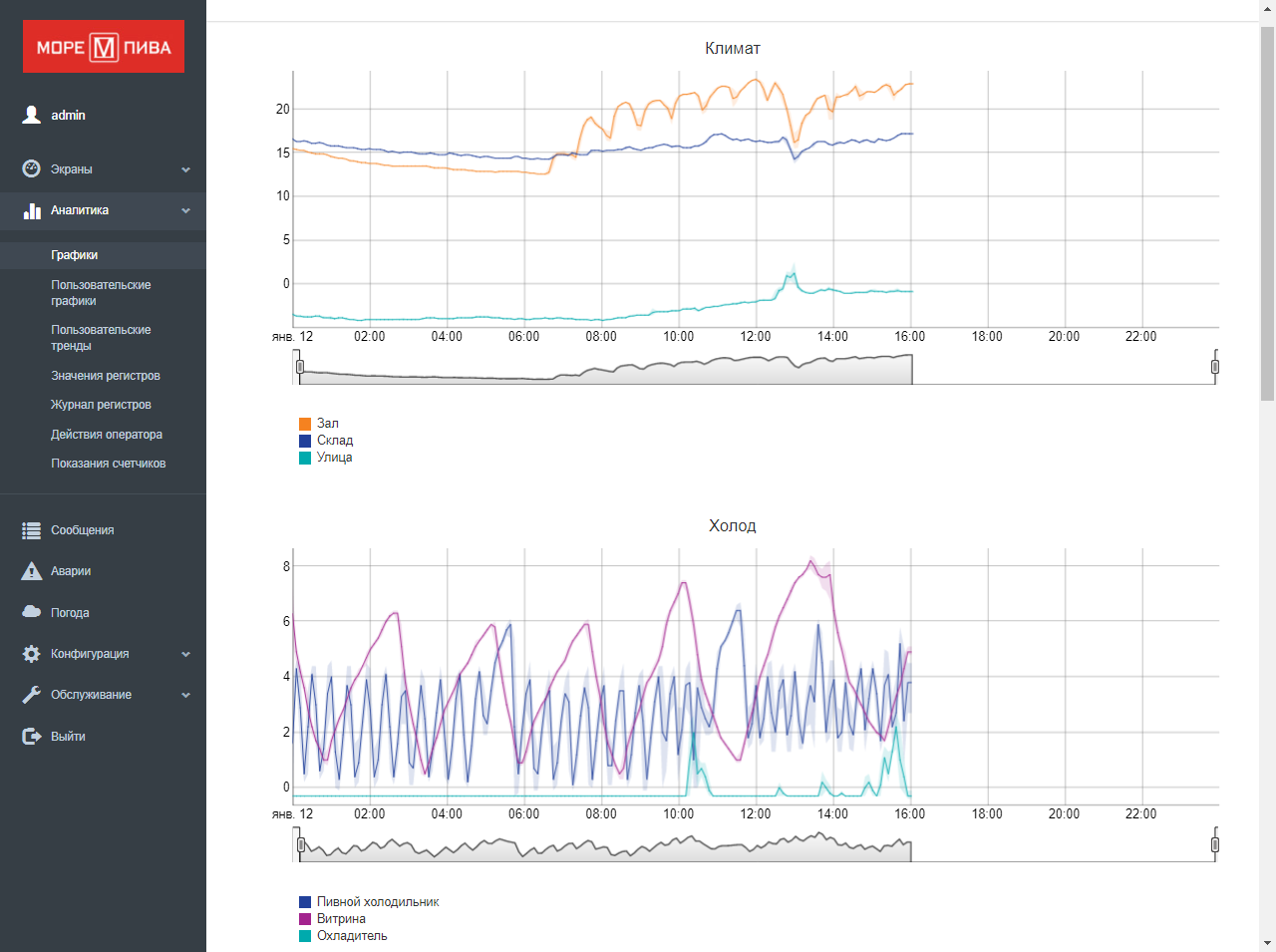
The refrigerator and showcase did not have a temperature controller with a communication interface (otherwise it could also have been connected to the RS-485’s built-in WebHMI port), so 1Wire sensors were used – thanks to small dimensions, this sensor can be “painlessly” installed in a refrigerator .
Also in the warehouse there was a cooler, in which through the cooled water pass the pipes with drinks. This cooler is also switched off at night for non-round-the-clock shops using a controlled outlet. The temperature in the cooler is also monitored with 1-Wire sensors.
Lighting
The lighting control consisted of turning on the ad light in the dark and monitoring the position of the light switches in the room. The sunset time was used to turn on the ad light. For non-round-the-clock shops, the backlight is turned off at the end of the working day. for round-the-clock – at dawn. The times of sunrise and sunset were read from the internal weather registers of WebHMI.
Power supply
As it was mentioned above, the objects were not designed for subsequent dispatching, therefore, in order to take into account the power consumed by the store and loads, SDM-530 technical meters with Modbus RTU interface were added, providing all electrical parameters. The power of some consumers was also recorded using “smart” outlets. Tools for analyzing the use of resources on Level2 made it convenient to analyze the energy consumption of different stores with conversion to unit area, in money, etc. The report data can be exported to the Excel workbook for further analysis, in addition, the data registered by the system can be obtained directly from the device through the API in any application.
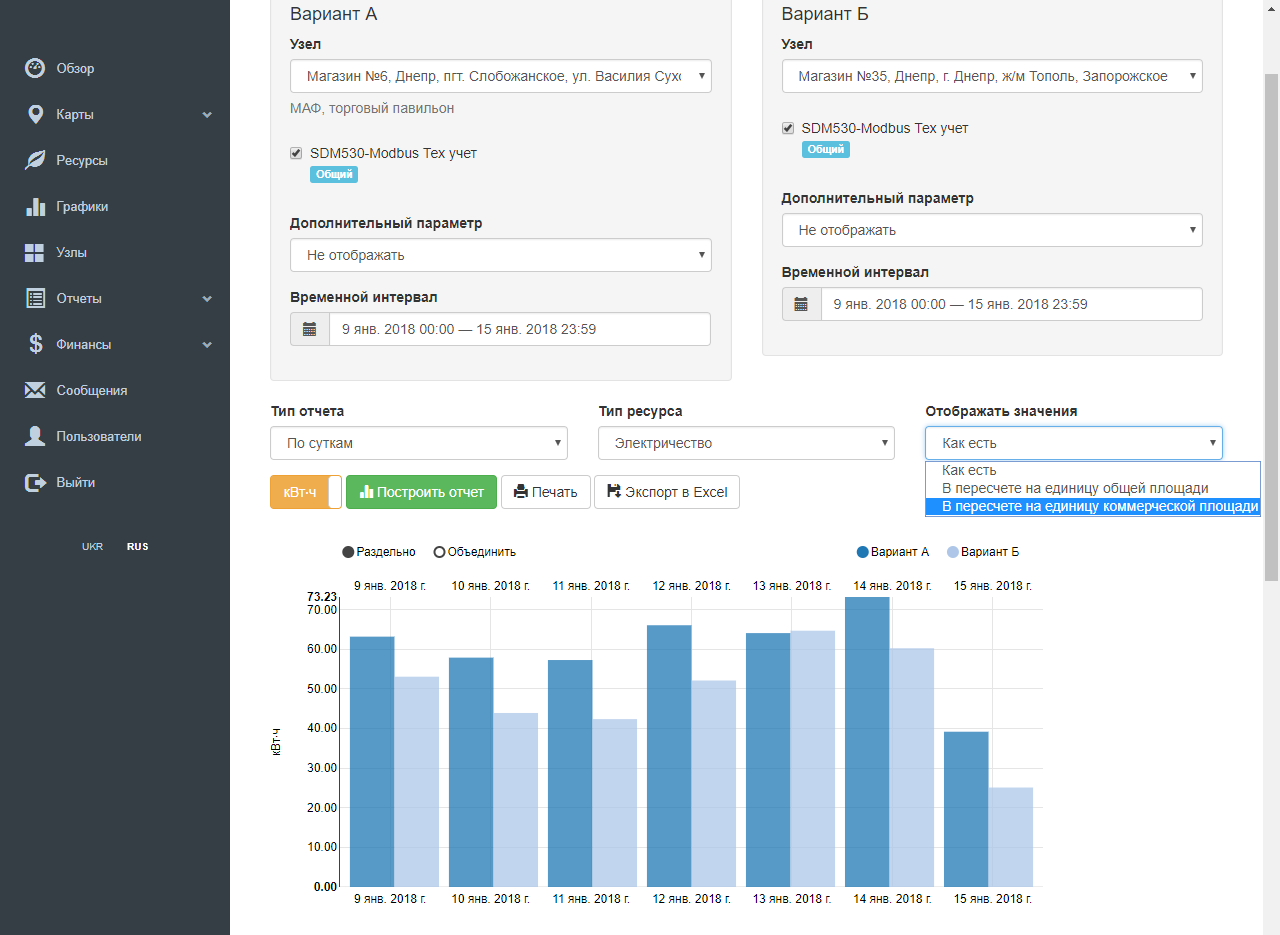
Benefits
This application is an ideal illustration of the concept laid out in WebHMI when developing – monitoring and managing a network of distributed objects and choice of such a customer as a trading network is the best confirmation of this. To date, it is difficult to imagine another solution that would cope with such a task for a very modest budget. WebHMI has all the necessary functionality on board – the necessary SCADA functionality on board, interfaces for integration into any network, web-interface and the ability to manage simultaneously several operators (retail network manager, technical service, analytics department) with different access rights, from different devices ( including smartphones and tablets) both from a local network, via Wi-Fi, and remotely via the Internet.
Thus, WebHMI perfectly solves the problem of management and monitoring of engineering systems at the local level. To manage multiple nodes and display the status of the entire network, a ready-made cloud service Level 2 is used – the top layer for systems built on WebHMI.
The combination of two approaches: “master slave” on the lower level of WebHMI and “client-server” interaction with Level2 makes it easy to scale the system without loss of performance (the operator interacts with nodes in real time, sees the response of the system to the effects, the upper layer is transmitted only key parameters for assessing the state in general and analysts). Level2 also provides remote access to sites using VPN technology without using fixed IP addresses (actual for 3G connectivity, and large corporate networks).
Thus, the customer got an effective tool for energy management of its facilities as a unified mass-produced solution. The time of installation of such a system is 1-2 days, and the economic effect of its implementation should fully justify itself.